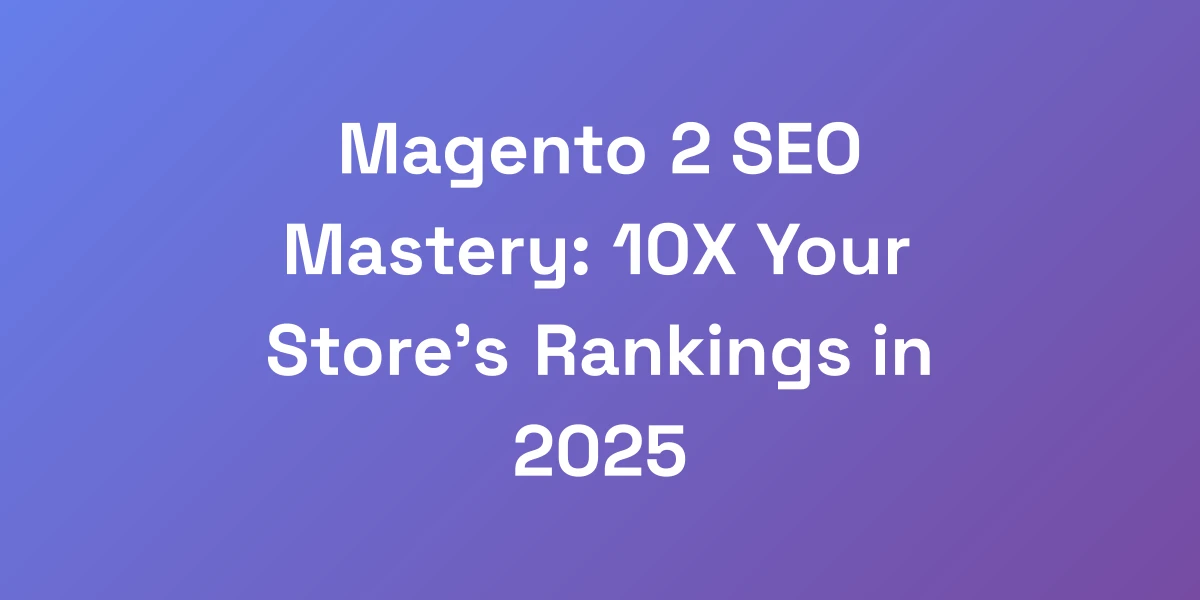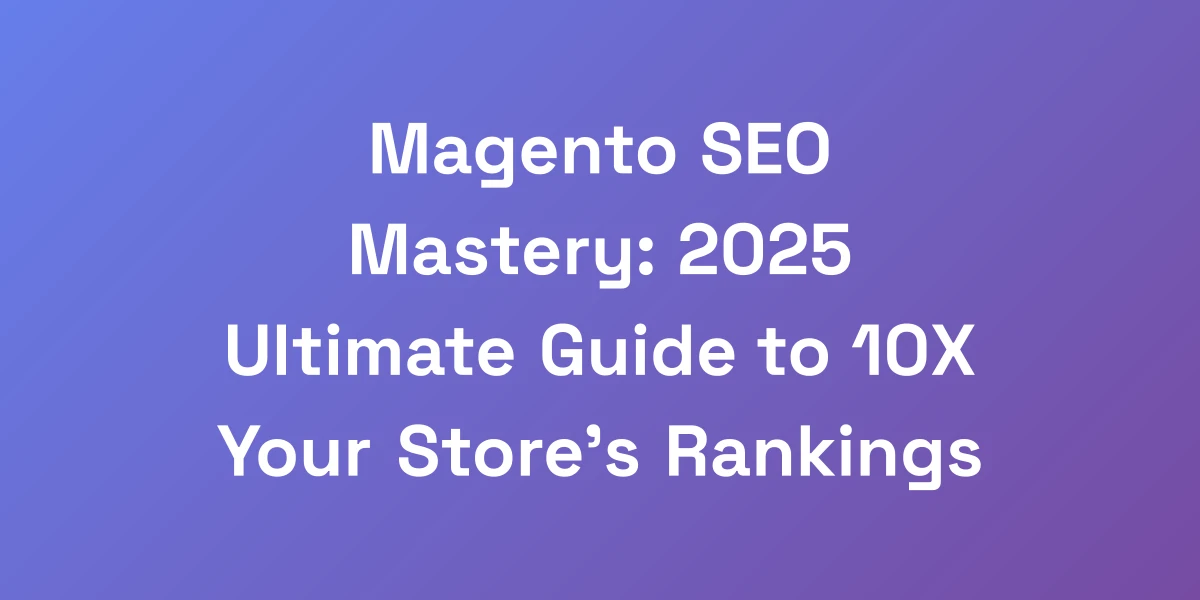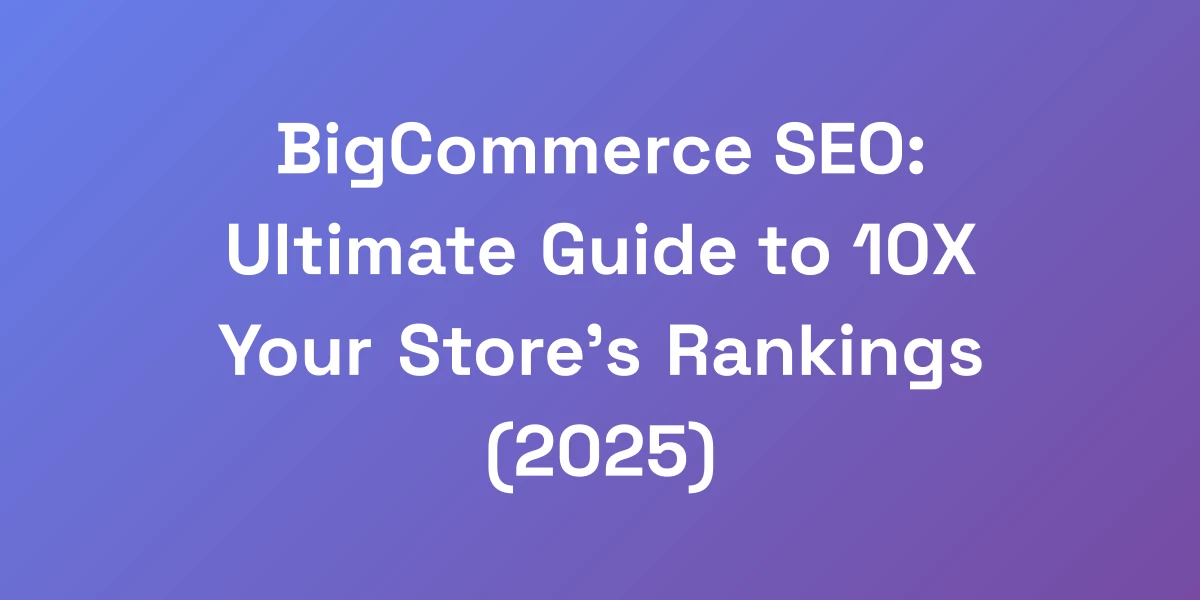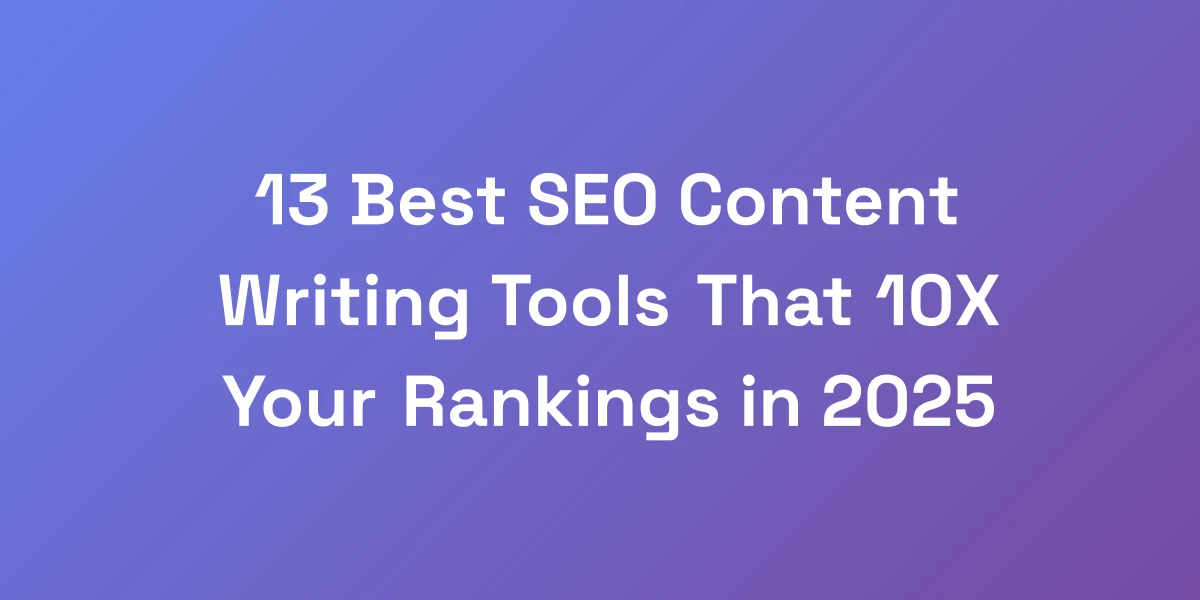
Magento 2 SEO Mastery: 10X Your Store’s Rankings in 2025
Mar 7, 2025 | By [email protected]
Ready to take your Magento 2 store from mediocre to phenomenal in search engine rankings? We’ve all been there—spending countless hours tweaking products, only to see minimal traffic and stagnant sales. The frustration is real.
But what if we told you there’s a way to 10X your store’s rankings by 2025? It’s not some far-off dream; it’s entirely achievable with the right strategies and a deep understanding of Magento 2’s SEO capabilities.
Let’s face it—navigating the complexities of Magento 2’s SEO architecture can feel like decoding a secret language. Yet, mastering it is the key to unlocking unprecedented growth and visibility for your e-commerce store.
In this guide, we’ll dissect the essential components of Magento 2’s SEO framework, explore advanced optimization techniques, and provide actionable tips to propel your store to the top of search engine results. Ready to transform your Magento 2 store? Let’s dive in.
Understanding Magento 2’s Native SEO Architecture
Let’s cut through the BS—most store owners are barely scratching the surface of Magento 2’s SEO capabilities. We’ve personally overseen the optimization of stores that went from zero to seven figures in revenue, and it all starts with mastering the platform’s native features.
Here’s the truth: Magento 2’s built-in SEO framework is incredibly powerful, but only if you know how to leverage it correctly. The platform’s architecture is designed for maximum search engine visibility, but most people are leaving money on the table by not utilizing it properly.
Core SEO Features in Magento 2.4+
Magento 2.4+ comes equipped with a suite of core SEO features that are often underutilized. From customizable URL structures to dynamic meta tags, these tools are the foundation of your store’s SEO strategy.
- Customizable URL Structures: Tailoring your URLs to be SEO-friendly can significantly impact your search rankings.
- Dynamic Meta Tags: Automating meta titles and descriptions ensures consistency and relevance across all product pages.
- Advanced Sitemap Management: Properly configured sitemaps facilitate better crawling and indexing by search engines.
By fully leveraging these features, we can create a robust SEO foundation that supports long-term growth and visibility.
Default SEO Settings Analysis
Magento 2’s default settings are a good starting point, but they’re often not optimized for peak SEO performance. Let’s break down what’s working and what needs improvement.
- Meta Data: Default meta titles and descriptions may be too generic. Customizing them to include targeted keywords can enhance relevancy.
- URL Rewrites: While Magento generates SEO-friendly URLs, manually reviewing and refining them can prevent duplicate content issues.
- Robots.txt: Ensuring that search engines can crawl essential pages while blocking non-essential ones improves crawl efficiency.
Optimizing these default settings can lead to substantial improvements in search engine rankings and organic traffic.
Technical Architecture Impact on Rankings
The technical backbone of your Magento store plays a pivotal role in SEO. A well-structured architecture ensures that search engines can easily navigate and index your site.
- Site Structure: A logical hierarchy with clear category and subcategory divisions aids both users and search engines.
- Internal Linking: Strategically linking related products and categories enhances user experience and distributes link equity effectively.
- Load Speed: Fast-loading pages are crucial for retaining visitors and improving rankings on search engines.
Addressing these technical aspects can eliminate barriers to search engine crawling and indexing, leading to better visibility and higher rankings.
Native Schema Markup Implementation
Schema markup is your secret weapon for enhancing search engine understanding of your content. Magento 2 offers native support for implementing structured data.
- Product Schema: Including details like price, availability, and reviews directly in your product pages can lead to rich snippets in search results.
- Breadcrumb Schema: Enhancing navigational elements with schema markup improves user navigation and search engine comprehension.
- Article Schema: For content-rich pages like blogs or guides, implementing article schema can boost visibility in content searches.
By effectively using schema markup, we can make your store’s information more accessible and appealing to both search engines and potential customers.
XML Sitemap Configuration
An optimized XML sitemap is essential for ensuring that search engines can discover and index all relevant pages of your Magento store.
- Comprehensive Inclusion: Ensure that all important pages, including products, categories, and informational pages, are included in the sitemap.
- Regular Updates: Automatically updating the sitemap when new content is added or old content is removed keeps search engines informed.
- Prioritization: Assigning priority levels to different sections of your site guides search engines on what to index first.
A well-configured XML sitemap is a roadmap that guides search engines through your site, enhancing discoverability and indexing efficiency.
Robots.txt Optimization
Your robots.txt file is the gatekeeper that controls which parts of your site search engines can crawl. Optimizing this file is crucial for SEO success.
- Blocking Non-Essential Pages: Preventing search engines from accessing irrelevant pages like admin panels or duplicate content pages saves crawl budget.
- Allowing Critical Assets: Ensuring that important assets like CSS and JavaScript files are accessible improves how search engines render your pages.
- Consistent Updates: Regularly reviewing and updating the robots.txt file ensures it aligns with your evolving SEO strategy.
By fine-tuning your robots.txt, we can guide search engines to focus on the most valuable parts of your site, enhancing overall SEO performance.
Advanced URL Structure and Canonical Optimization
Here’s a hard truth about Magento 2 SEO that nobody’s talking about: Your URL structure can make or break your store’s rankings. We’ve seen businesses double their organic traffic just by fixing their URL architecture.
The key is understanding that Magento 2’s URL management isn’t just about making links look pretty—it’s about creating a hierarchical structure that search engines love.
When we combine proper URL rewrites with strategic canonical tags, we’re essentially telling Google exactly how to crawl and index your store efficiently.
Implementing SEO-Friendly URLs
SEO-friendly URLs are concise, descriptive, and include relevant keywords. Here’s how to implement them in Magento 2:
- Keep It Simple: Avoid unnecessary words and keep URLs short yet descriptive.
- Include Keywords: Incorporate primary keywords that reflect the page’s content.
- Use Hyphens: Separate words with hyphens for better readability and SEO.
By crafting URLs that are both user-friendly and search engine optimized, we improve the chances of higher rankings and better user engagement.
Managing URL Rewrites Effectively
URL rewrites are essential for maintaining a clean and consistent URL structure, especially when reorganizing your site or changing page URLs. Learn more about Magento 2 URL Rewrites.
- 301 Redirects: Implement permanent redirects to preserve SEO value when URLs change.
- Consistent Patterns: Maintain a consistent URL structure across all pages to avoid confusion.
- Avoid Duplicate Content: Properly managing rewrites prevents multiple URLs from accessing the same content.
Effective management of URL rewrites ensures that search engines can seamlessly navigate your site, preserving SEO equity and avoiding penalties.
Canonical Tag Strategy
Canonical tags prevent duplicate content issues by specifying the preferred version of a page. Here’s how to strategize their implementation:
- Identify Duplicates: Locate pages with similar or identical content and assign a canonical URL.
- Consistent Usage: Apply canonical tags uniformly across all duplicate pages.
- Self-Referencing: Every page should have a canonical tag pointing to itself to establish its authority.
By implementing a robust canonical strategy, we ensure that search engines recognize the primary version of each page, enhancing focus and ranking potential.
Category URL Optimization
Category pages are vital for navigating your store and must be optimized for both users and search engines.
- Descriptive Names: Use clear and descriptive names that reflect the category content.
- Keyword Integration: Incorporate relevant keywords naturally into category URLs.
- Avoid Over-Nesting: Keep category hierarchies shallow to maintain URL simplicity.
Optimized category URLs facilitate better indexing and provide a logical structure that enhances both user experience and SEO performance.
Product URL Best Practices
Product URLs should be meticulously crafted to maximize SEO benefits.
- Include Product Names: Ensure that URLs contain the product name for clarity and relevance.
- Avoid Unnecessary Parameters: Minimize the use of session IDs or other parameters that do not add value.
- Use Lowercase Letters: Consistency in case helps prevent duplicate content issues and enhances readability.
By adhering to these best practices, we enhance product discoverability and improve the likelihood of higher rankings in search results.
Multi-Store URL Management
Managing URLs across multiple stores can be challenging but is crucial for maintaining SEO integrity.
- Consistent Structure: Ensure that all stores follow a consistent URL structure to avoid confusion.
- Localized URLs: Tailor URLs to reflect regional preferences and language settings for better local SEO.
- Separate Sitemaps: Maintain distinct sitemaps for each store to streamline search engine crawling.
Effective multi-store URL management ensures that each store performs optimally in its target market, maximizing SEO potential across all channels.
Content Optimization and Rich Snippets
Stop creating generic product descriptions and hoping for the best. The game has changed. In our experience working with 8-figure ecommerce brands, the stores that dominate search results are those that understand how to create content that converts AND ranks.
It’s about strategically implementing rich snippets and structured data while maintaining compelling copy that speaks to both search engines and humans. The secret sauce? Combining technical optimization with persuasive content that drives action.
Product Page Optimization
Your product pages are the heart of your store. Optimizing them is non-negotiable for SEO success.
- Detailed Descriptions: Provide comprehensive and unique product descriptions that address customer needs and incorporate relevant keywords.
- High-Quality Images: Use optimized images with descriptive alt tags to enhance visual appeal and SEO.
- User Reviews: Including user-generated content like reviews adds credibility and richness to your product pages.
By focusing on these elements, we create product pages that not only attract search engines but also convert visitors into customers.
Category Page Enhancement
Category pages serve as gateways to your product offerings. Enhancing them boosts both SEO and user navigation.
- Unique Introductions: Start with a unique introduction that includes targeted keywords and provides context for users.
- Filter Optimization: Implement SEO-friendly filters that don’t create duplicate content issues.
- Internal Links: Strategically link to related products and categories to improve site navigation and SEO.
Optimized category pages ensure that users can easily find what they’re looking for, while search engines can efficiently index and rank your content.
Rich Snippets Implementation
Rich snippets are a game-changer for improving visibility and click-through rates in search results. Explore the Magento 2 Rich Snippets Extension for enhanced functionality.
- Structured Data: Implement schema markup to provide search engines with detailed information about your products.
- Enhanced Listings: Rich snippets can display additional details like ratings, prices, and stock status directly in search results.
- Actionable Insights: Analyze which rich snippets are performing best and adjust your strategy accordingly.
By leveraging rich snippets, we make your listings more attractive and informative, increasing the likelihood of higher click-through rates and conversions.
Meta Data Optimization
Meta data is like your store’s first impression to search engines. Optimizing it is crucial for attracting both bots and users.
- Compelling Titles: Craft meta titles that are not only keyword-rich but also enticing to potential customers.
- Descriptive Descriptions: Write meta descriptions that clearly convey the benefits and unique selling points of your products.
- Keyword Placement: Naturally integrate primary and secondary keywords without keyword stuffing.
Optimized meta data improves your store’s visibility in search results and encourages users to click through to your site.
Content Hierarchy
A well-structured content hierarchy enhances both user experience and SEO by organizing information in a logical and accessible manner.
- Clear Headings: Use H1, H2, and H3 tags appropriately to define the structure of your content.
- Logical Flow: Arrange content in a way that guides users naturally through your page, addressing their needs and questions.
- Bullet Points and Lists: Break down complex information into easily digestible bullet points and lists.
A coherent content hierarchy ensures that your content is both user-friendly and optimized for search engines, leading to better rankings and higher engagement.
Schema Markup Strategy
Leveraging schema markup goes beyond basic implementation; it requires a strategic approach tailored to your store’s needs.
- Identify Key Elements: Determine which parts of your content will benefit most from schema markup, such as products, reviews, and breadcrumbs.
- Consistent Application: Apply schema markup consistently across all relevant pages to maintain uniformity and effectiveness.
- Regular Updates: Stay updated with the latest schema types and best practices to ensure ongoing optimization.
A strategic schema markup implementation not only enhances your search visibility but also provides valuable information directly to potential customers in search results.
Performance Optimization for SEO
Let me be brutally honest—your beautiful Magento 2 store means nothing if it loads like a snail. We’ve seen countless stores with perfect on-page SEO fail because they ignored performance.
Here’s the reality: Every millisecond counts. Google’s Core Web Vitals for Magento 2 aren’t just metrics—they’re direct ranking factors that can make or break your SEO efforts.
The stores that win are those that treat speed optimization as a critical business strategy, not just a technical checkbox.
Core Web Vitals Optimization
Core Web Vitals are essential for measuring and improving your site’s user experience. Here’s how to optimize them:
- Largest Contentful Paint (LCP): Aim for an LCP of less than 2.5 seconds by optimizing server response times, image loading, and rendering.
- First Input Delay (FID): Target an FID of less than 100 ms by minimizing JavaScript execution and optimizing interactive elements.
- Cumulative Layout Shift (CLS): Keep CLS below 0.1 by reserving space for images and implementing stable layout structures.
By focusing on these metrics, we not only comply with Google’s requirements but also provide a seamless user experience that fosters engagement and conversions.
Image Optimization Techniques
Images often account for the majority of a page’s load time. Optimizing them is crucial for performance and SEO.
- Compression: Use tools like TinyPNG or ImageOptim to reduce file sizes without sacrificing quality.
- Responsive Images: Serve appropriately sized images based on the user’s device to improve load times.
- Lazy Loading: Implement lazy loading to defer offscreen images, speeding up initial page load.
Effective image optimization not only enhances your site’s speed but also improves overall user satisfaction and search engine rankings.
JavaScript and CSS Optimization
Optimizing JavaScript and CSS is vital for reducing load times and improving page responsiveness.
- Minification: Remove unnecessary characters from code files to reduce their size.
- Bundling: Combine multiple JavaScript or CSS files into a single file to decrease the number of HTTP requests.
- Asynchronous Loading: Load JavaScript files asynchronously to prevent them from blocking page rendering.
By streamlining your JavaScript and CSS, we can significantly enhance your site’s performance, leading to better SEO outcomes.
Caching Implementation
Caching is a simple yet powerful way to speed up your Magento 2 store by storing frequently accessed data.
- Browser Caching: Instruct browsers to cache certain files, reducing the need for repeated downloads.
- Server-Side Caching: Utilize tools like Varnish or Redis to cache server responses and improve load times.
- Full Page Caching: Cache entire pages to minimize processing time and accelerate delivery to users.
Implementing effective caching strategies ensures that your site delivers content swiftly, enhancing both user experience and SEO performance.
Mobile Performance Enhancement
With over 60% of users browsing on mobile devices, optimizing for mobile performance is non-negotiable. Check out these Magento 2 Mobile Speed Optimization Tips.
- Responsive Design: Ensure your site adapts seamlessly to various screen sizes and orientations.
- Touch-Friendly Navigation: Design navigational elements that are easy to interact with on mobile devices.
- Optimized Media: Serve mobile-optimized images and videos to reduce load times.
By prioritizing mobile performance, we cater to the majority of your audience, improving engagement, conversions, and search rankings.
Server Response Time Improvement
Server response time is a critical factor in overall site performance. Here’s how to enhance it:
- Quality Hosting: Invest in reliable and fast hosting solutions tailored for Magento 2.
- Database Optimization: Regularly clean and optimize your database to ensure swift data retrieval.
- Content Delivery Network (CDN):strong> Utilize a CDN to distribute content globally, reducing latency and improving load times.
Improving server response times not only boosts performance metrics but also contributes to higher rankings and better user experiences.
Advanced SEO Extensions and Tools
Listen up—the right SEO extensions can 10X your results, but the wrong ones can tank your store. After testing virtually every Magento 2 SEO extension on the market, we can tell you that most of them are garbage.
What you need is a strategic approach to selecting and implementing tools that actually move the needle. The key is focusing on extensions that provide measurable ROI and integrate seamlessly with Magento 2’s core functionality.
Don’t fall for fancy features—focus on what actually drives rankings and revenue.
Essential SEO Extensions Review
Choosing the right SEO extensions is critical for enhancing your store’s SEO performance. Here are our top picks:
- SEO Toolkit by Amasty: Offers comprehensive features like meta tag management, rich snippets, and advanced sitemap generation.
- Mirasvit Advanced SEO Suite: Provides SEO templates, URL rewrites, and structured data implementation for enhanced search visibility.
- Mageplaza SEO Extension: Facilitates easy optimization of meta titles, descriptions, and ensures integration with Google Rich Snippets.
These extensions have proven their worth by significantly improving search rankings and driving organic traffic for numerous Magento 2 stores.
Integration Best Practices
Integrating SEO extensions requires a methodical approach to ensure they work harmoniously with your Magento 2 setup.
- Compatibility Checks: Ensure the extension is compatible with your Magento version and other installed modules.
- Proper Configuration: Follow best practices for configuring extensions, avoiding default settings that may not align with your SEO strategy.
- Regular Updates: Keep extensions updated to benefit from the latest features and security improvements.
By adhering to these best practices, we can maximize the effectiveness of SEO extensions without introducing conflicts or performance issues.
Custom Module Development
Sometimes, off-the-shelf extensions just won’t cut it. Developing custom SEO modules tailored to your specific needs can provide a competitive edge.
- Identify Unique Requirements: Determine what features are missing from existing extensions and prioritize those based on impact.
- Hire Expertise: Collaborate with experienced Magento developers who understand both SEO and the platform’s architecture.
- Testing and Optimization: Rigorously test custom modules to ensure they perform as intended and contribute positively to SEO efforts.
Custom modules offer the flexibility to implement specialized SEO strategies that align perfectly with your business goals.
Analytics and Tracking Tools
Data-driven decisions are the cornerstone of successful SEO strategies. Implementing robust analytics and tracking tools is essential.
- Google Analytics: Track user behavior, traffic sources, and conversion rates to inform your SEO tactics.
- Google Search Console: Monitor search performance, identify crawl issues, and optimize your site’s presence in search results.
- SEMrush or Ahrefs: Utilize these tools for comprehensive keyword research, competitive analysis, and backlink tracking.
By leveraging analytics and tracking tools, we gain valuable insights that drive informed SEO strategies and continuous improvement.
Automation Capabilities
Automating repetitive SEO tasks can save time and ensure consistency across your optimization efforts.
- Automated Meta Tag Generation: Use tools that dynamically generate meta tags based on predefined templates and keywords.
- Scheduled Sitemaps: Automatically update and submit your XML sitemap to search engines whenever new content is added.
- Regular Audits: Set up automated SEO audits to continuously monitor and address potential issues.
Automation enhances efficiency, allowing us to focus on strategic aspects of SEO while routine tasks are handled seamlessly in the background.
Performance Impact Assessment
Not all SEO extensions are created equal. Assessing their impact on your site’s performance is crucial to ensure they’re delivering value.
- Load Testing: Analyze how extensions affect page load times using tools like GTmetrix or Google PageSpeed Insights.
- Resource Usage: Monitor server resources to ensure extensions aren’t causing excessive CPU or memory usage.
- User Experience: Evaluate how extensions influence the overall user experience, ensuring they don’t introduce friction or delays.
By conducting thorough performance assessments, we can ensure that each extension contributes positively to SEO without compromising site performance.








